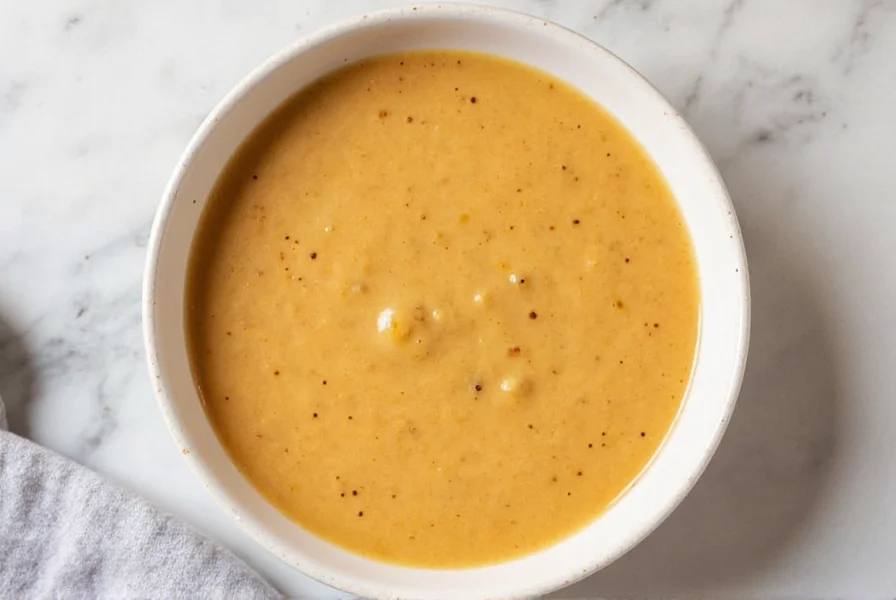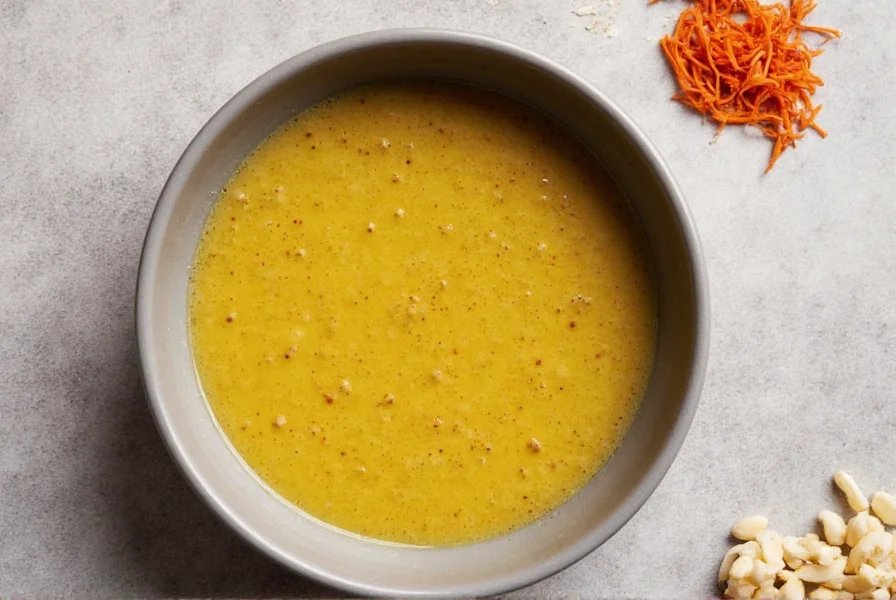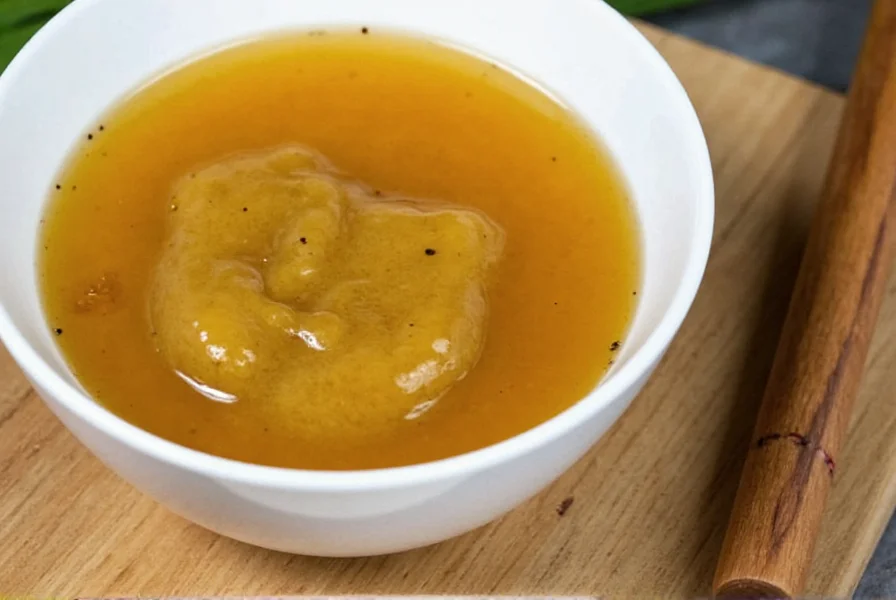Asian ginger dressing has become a staple in modern kitchens for good reason. This vibrant sauce bridges traditional Asian culinary techniques with contemporary flavor preferences, offering a refreshing alternative to heavier cream-based dressings. With roots in Japanese and Chinese cuisine, this dressing showcases how simple ingredients can create complex, harmonious flavors when properly balanced.
Essential Ingredients and Their Roles
Creating an authentic Asian ginger dressing requires understanding each component's contribution to the final flavor profile. While recipes vary across regions, these core ingredients form the foundation:
| Ingredient | Function | Substitution Options |
|---|---|---|
| Fresh ginger root | Provides bright, spicy warmth and distinctive aroma | Ginger paste (1:1 ratio) or ground ginger (1/4 tsp = 1 tbsp fresh) |
| Unseasoned rice vinegar | Offers mild acidity without overpowering other flavors | Apple cider vinegar or champagne vinegar |
| Light soy sauce | Contributes umami depth and saltiness | Coconut aminos (for gluten-free) or tamari |
| Toasted sesame oil | Adds nutty richness and authentic Asian flavor | None (essential for authentic taste) |
| Neutral oil (grapeseed/avocado) | Creates emulsion and smooth texture | Vegetable oil or light olive oil |
The magic happens when these elements combine in proper proportions. Freshly grated ginger provides enzymatic activity that enhances flavor development over time, while the vinegar's acidity balances the soy sauce's saltiness. Many home cooks underestimate the importance of using fresh ginger rather than powdered—this single choice dramatically affects the dressing's brightness and complexity.

Classic Homemade Asian Ginger Dressing Recipe
This authentic preparation yields approximately 1 cup of dressing. The recipe emphasizes technique as much as ingredients for optimal flavor development:
- Finely grate 3 tablespoons fresh ginger using a microplane (avoid pre-minced ginger for superior flavor)
- Mince 2 garlic cloves to a paste using salt as abrasive
- Whisk together 1/4 cup rice vinegar, 3 tablespoons soy sauce, 2 tablespoons maple syrup, and 1 tablespoon sesame oil
- Slowly drizzle in 1/2 cup neutral oil while whisking vigorously to create emulsion
- Add ginger and garlic, then whisk in 1 teaspoon toasted sesame seeds
- Let mixture rest at room temperature for 20 minutes before use to allow flavors to meld
Professional chefs recommend preparing this dressing at least two hours before serving. The resting period allows the ginger's volatile compounds to mellow while enhancing the overall flavor integration. For restaurant-quality results, many culinary experts use a 3:1 oil-to-vinegar ratio as the foundation for balanced acidity.
Variations for Dietary Needs and Flavor Preferences
Adapting this versatile dressing to different dietary requirements maintains its essential character while accommodating various needs:
- Gluten-free Asian ginger dressing: Substitute tamari or coconut aminos for soy sauce while maintaining the same volume
- Vegan Asian ginger dressing without sugar: Replace honey or maple syrup with date syrup or omit sweetener for a more savory profile
- Low-sodium version: Use reduced-sodium tamari and increase rice vinegar by 1 tablespoon to maintain balance
- Spicy ginger dressing: Add 1-2 teaspoons of sambal oelek or 1/2 teaspoon red pepper flakes during emulsification
- Creamy ginger variation: Blend in 2 tablespoons of tahini or Greek yogurt for a richer texture
Optimal Pairing Suggestions
Understanding which dishes best showcase Asian ginger dressing elevates your culinary presentation. This dressing's bright acidity and ginger warmth complement specific food groups particularly well:
- Salad applications: Works exceptionally with crisp vegetables like napa cabbage, snow peas, and shredded carrots. Try it with our recommended easy Asian slaw recipe using asian ginger dressing for a refreshing side dish.
- Protein pairings: Excellent as a marinade for salmon, chicken, or tofu. The enzymes in fresh ginger help tenderize proteins while adding flavor.
- Grain bowls: Drizzle over quinoa or brown rice bowls with roasted vegetables for an instant flavor boost.
- Dipping sauce: Thin with additional rice vinegar for spring rolls or dumplings.
Chefs note that the dressing's acidity cuts through rich flavors, making it particularly effective with fatty fish like salmon or marbled meats. For salad applications, apply the dressing just before serving to prevent wilting of delicate greens—a common mistake in homemade asian ginger dressing preparation.
Storage Guidelines and Shelf Life
Proper storage maintains both safety and flavor quality. When stored correctly, homemade Asian ginger dressing lasts:
- Room temperature: Up to 2 hours (ideal for immediate use)
- Refrigerated in airtight container: 7-10 days
- Freezer: Up to 3 months (thaw in refrigerator before use)
Separation is normal due to the oil-based emulsion. Simply shake or whisk vigorously before each use. Avoid storing in metal containers as the vinegar can react with the metal. For extended freshness, some culinary professionals add 1/4 teaspoon of citric acid as a natural preservative without altering flavor.

Common Preparation Mistakes to Avoid
Even experienced cooks make these frequent errors when preparing authentic asian ginger dressing recipes:
- Using old ginger: Stale ginger lacks volatile oils that provide signature flavor. Look for firm, smooth-skinned roots with minimal wrinkles.
- Incorrect oil ratio: Too much oil creates a greasy texture; too little prevents proper emulsification.
- Adding ingredients in wrong order: Always emulsify vinegar and oil components before adding ginger to maximize flavor extraction.
- Over-blending ginger: Processing ginger too finely can make the dressing bitter due to released cellulose.
- Serving immediately: Skipping the resting period results in harsh, unbalanced flavors.
For the most vibrant flavor in your easy asian ginger dressing in 10 minutes, grate ginger against the grain rather than with it—this releases more flavor compounds while minimizing fibrous texture.
Conclusion
Mastering Asian ginger dressing opens countless culinary possibilities beyond basic salad applications. By understanding the science behind ingredient interactions and respecting traditional preparation methods, home cooks can create restaurant-quality results. The dressing's versatility across proteins, vegetables, and grain dishes makes it a valuable addition to any recipe repertoire. Remember that small adjustments to sweetness, acidity, or spice levels can transform the same basic recipe to suit different dishes and preferences.
Frequently Asked Questions
Can I make Asian ginger dressing without sesame oil?
Yes, though sesame oil provides authentic flavor. Substitute with roasted walnut oil for similar nuttiness or omit entirely for a lighter version. For best results in gluten-free asian ginger dressing variations, maintain the oil ratio by increasing neutral oil proportionally.
Why does my homemade Asian ginger dressing separate?
Separation occurs when emulsion breaks, typically from improper oil incorporation. To fix this, slowly whisk additional rice vinegar (1 teaspoon at a time) into the separated mixture. For stable easy asian ginger dressing in 10 minutes, ensure all ingredients are at room temperature before mixing and add oil gradually while whisking continuously.
How can I make my Asian ginger dressing less sweet?
Reduce or eliminate sweeteners like honey or maple syrup. For balanced authentic asian ginger dressing recipes, increase rice vinegar by 1-2 tablespoons to compensate for reduced sweetness. Some traditional Japanese variations use only natural vegetable sweetness without added sweeteners.
What's the best way to store Asian ginger dressing for meal prep?
Store in a glass mason jar with tight-sealing lid, filling to within 1 inch of the top to minimize air exposure. For optimal asian ginger dressing storage tips, keep in the refrigerator's main compartment (not the door) where temperature remains most consistent. Shake well before each use as separation is natural.











 浙公网安备
33010002000092号
浙公网安备
33010002000092号 浙B2-20120091-4
浙B2-20120091-4